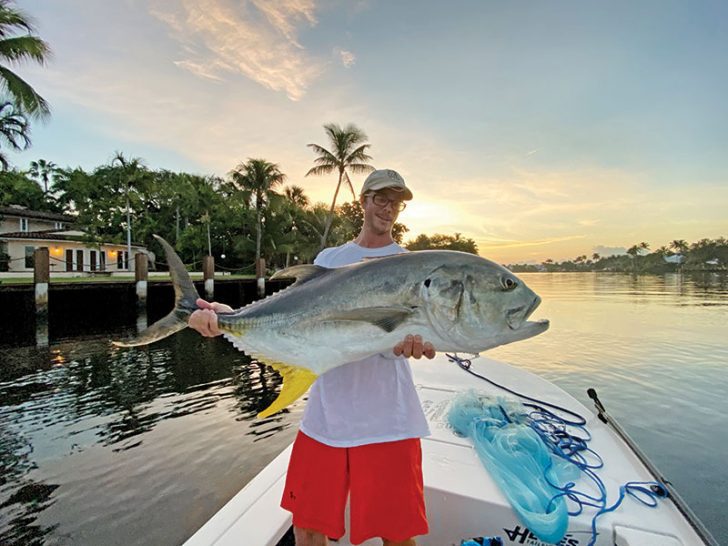Often overlooked and under appreciated, the jack crevalle still manages to fit every facet of gamefish. Fast, strong, and powerful can all be used to describe these hard fighting members of the Carangidae family. Perhaps its reputation becomes tainted due to the aggressive nature of this fish, striking out in voracity at any fast moving object that comes across its path. However, this aggressiveness should not be confused with lack of intelligence, especially with fish of larger size.
Jack crevalle can be caught all over the state with a myriad of different techniques to land fish ranging in size from under a pound to well over 30. Don’t let that smaller ‘dork jack’ fool you either, as jacks are pound for pound, one of the toughest fighting inshore fish. A 20 pound jack is much harder to put the brakes on compared to a snook of equal size and they almost always know right where the structure is located.
Many times jacks have saved fishing trips when other fish aren’t biting or when it is too windy to venture offshore. Jacks also typically travel in schools meaning when you catch one you can often expect to catch multiple fish, leading to bent rods and sore arms. The first step in having success when it comes to catching jacks is securing frisky live bait. A large jack crevalle more than likely will not eat a lethargic bait because it needs something lively and fast moving to elicit its predatory instinct. A live mullet is a top bait and it is hard to beat, but live pilchards, sardines, goggle eyes and threadfins will all draw interest. Slow trolling anyone of these baits is a great way to cover territory and find fish. The mullet is best trolled by placing the hook in the mouth and pushing it through the top lip.
Jacks can be caught on artificials too and will even inhale a properly presented fly.
Leading the way is a topwater lure, followed by diving plugs and jigs. My favorite all time lure is the TopDog made by Mirrolure. Worked fast or in a quick walk the dog pattern can lead to exciting and explosive topwater bites.
Jacks cover a wide territory from wrecks out in the ocean, to the inlet and all the way back in the rivers and estuaries. Inshore, look for moving water at the mouths of canals and rivers and along structure, but don’t be afraid to cast out into open water as jacks will often stage out in the open as well. Jacks are crepuscular animals, meaning they are mostly active at dawn and dusk, but still can be caught throughout the day and even at night if there is a feeding event such as the mullet run. Also look for areas where bait is holding, particularly mullet. Often times these places will have an event every morning where packs of jacks take mullet to the seawall for an easy, early morning meal. These fish are the best to target with artificial or the fly as they are aggressive and more susceptible to making a mistake. Cast into the white water and move it as soon as it lands and you should be tight right away.
When rigging for jacks it is important to keep in mind the size of the fish you will be targeting. Typically in Fort Lauderdale around this time of year the jack crevalle averages around 4 to 8 pounds and can be targeted with 12 pound mono or any comparative braid, while in the spring when jacks are routinely over the 10 pound mark, it is wise to use 15 to 20 pound test. Even then some larger fish may still be lost. If you are consistently losing big fish, bump up to heavier braid and lock down the drag. Jacks are typically not leader shy. Although jacks don’t have rough mouths or teeth that warrant a heavy leader, fishing with a heavy leader can make all the difference when fishing around structure. A bimini twist of the main line tied to about 4 to 5 feet of 40 to 60 pound mono leader should do the trick. Vary your hook size depending on the size of your bait. A 3/0 to 4/0 circle hook is best for finger mullet and pilchards while a 5/0 to 6/0 is best for a standard 6 to 8 inch mullet or goggle eye. Beefy rods are best as jack fishing does not require much finesse. A star rod fitted with a 5000 size spinning reel is a good place to start for jacks of all sizes.
If you’re looking for a fun time fishing with explosive topwater bites, screaming drag and a day full of bent rods, look no further than the jack crevalle. These fish certainly deserve more credit than they are given, and will provide anglers of all skill levels with endless entertainment.
~ Zach Routman


